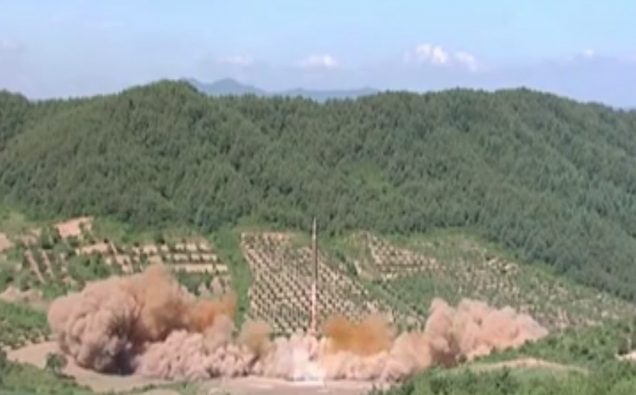
In early August, the world watched with growing anxiety as the governments in Washington and Pyongyang ramped up a war of words; each exchange was louder and more strident, each threat was more determined than the one before. The U.S. and North Korea have had tense relations since the end of war on the Peninsula in 1953. But in the heat of mid-summer the tension seemed worse than ever, as Kim Jung-Un and Donald Trump promised to wage war, if provoked.
Heated rhetoric between the two nations is not new. What seized the world’s attention this time is the possibility that war – always regarded as a potential catastrophe for both North and South Korea – might be waged with nuclear weapons. Observers agreed such a war would be a much wider catastrophe – one for all of Asia, and for the U.S. and its allies, with global implications.
The latest round in the war of words began with the North Korean test launch of a long-range guided missile, larger – and capable of flying farther – than any it had fired before. The Kim regime has conducted a growing number of missile tests in recent years, with the strategic goal of countering U.S. military strength with a nuclear capability of its own. The test missile launched in late July splashed down in the Pacific Ocean. But military experts say that a similar missile, if properly targeted and armed with a nuclear warhead, could hit a major city in the continental United States, potentially killing millions of Americans.
President Trump reacted to the test with an impromptu warning to Kim Jong-Un, saying further provocations “will be met with fire and fury like the world has never seen.” The unequivocal language of the President’s seemingly off-the-cuff remarks got the attention of people in Washington, Pyongyang, Beijing, and elsewhere, as critics said he was pushing too hard, and too far, toward a potential conflict. But in response to the criticism Mr. Trump said that perhaps his “fire and fury” comment “wasn’t tough enough”, adding that North Korea had “been doing this to our country for a long time.” It was time, he said, that “somebody stuck up for the people of this country and for the people of other countries.”
North Korea appeared to laugh off the President’s threats, calling his comments “a load of nonsense,” and threatened to launch missiles into the waters near the island of Guam in the South Pacific, a long-standing home for U.S. military forces. North Korea said missile launches simply awaited a decision by Kim Jong-Un.
This ratcheted up the verbal conflict even further, as President Trump said Kim was “not going to go around threatening” Guam, the United States, Japan, or South Korea – it’s “a whole new ballgame”, he said, and that Kim is “not getting away with it.”
By the end of a long, tense week, other U.S. officials had weighed in, with Secretary of State Rex Tillerson saying the American people could sleep well at night, knowing there wouldn’t be a nuclear exchange. Defense Secretary James Mattis, a former Marine Corps General, sounded a sterner note, warning that if North Korea fired on American territory, there would be war. The Chairman of the Joint Chiefs, General Joseph Dunford, voiced the goal that the war of words should be settled through diplomacy.
In Seoul, meantime, the South Korean government continued to prepare for ten days of long-scheduled joint military drills with US forces. South Korea’s President, Moon Jae-In, said those drills – aimed at testing his country’s military defenses – would continue in spite of objections from the North. Pyongyang had charged that the joint military exercises would be considered as preparation for an invasion of the North. President Moon denied the charge, and – speaking to the U.S. threats of raining down “fire and fury” against the North – said “military action on the Korean Peninsula can only be decided by South Korea,” which will “block war by all means.”
By mid-August, all parties had taken a step back from the brink of war, seemingly content with making bellicose statements. Kim Jung-Un, according to Pyongyang’s news agency, would take time to examine military plans with his commanding officers. China urged that all parties “uphold the general direction of dialogue, negotiation, and political settlement.” The Trump administration took a wait-and-see stance, with Defense Secretary Mattis warning that if North Korea attacked U.S. territory, it would be “game on.”
For a week or so in August the world held its breath, at least for a while, hoping there would be no war, with or without nuclear weapons, involving North and South Korea and the United States. Looking ahead, it isn’t at all clear that the world will be able to relax completely; the threat – abated, for now – has not gone away.


















